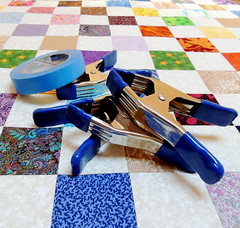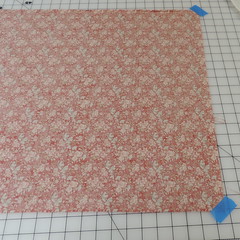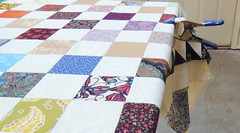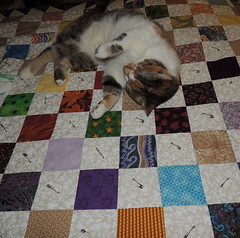 A few days ago, I posted that I was going to focus on learning to love the preparation phases of quilting that tend to slow me down or, when I resist them completely, stop working on one project and picking up something easier/more fun. One of those potentially project-stopping preparation processes is layering and basting a quilt.
A few days ago, I posted that I was going to focus on learning to love the preparation phases of quilting that tend to slow me down or, when I resist them completely, stop working on one project and picking up something easier/more fun. One of those potentially project-stopping preparation processes is layering and basting a quilt.I think, for me, there are two aspects to consider: attitude and technique.
Attitude
In terms of attitude, this weekend I was reminded of one of my favorite little books, Peace is Every Step, by Thich Nhat Hanh. It is about cultivating a mindfulness in everything we do ... and thinking about it made me consider being more mindful in my quilt making and remember that the care we take in each step makes the following one go more smoothly. Or, at least, that's what I was telling myself as I carefully pressed the checkerboard picnic quilt top and backing before layering and basting the quilt :-)Technique
When it comes to technique, of course, practice makes perfect ... but technique can also be improved, made more efficient and/or faster, by learning from others.Basting a quilt is something where I know that I have miles to go to perfect my technique ... and learn to love the process. I'd love your comments on how I could do it better/faster.
Bad knees and a lack of space make layering and basting on the floor impractical for me, so I use a table like this one, which is approximately 35 by 60 inches. Mine is covered with cutting mat. (Both acquired long ago either on sale or with coupons at JoAnn.)
 My tools of the trade (above) for securing the quilt sandwich are painters tape for smaller quilts and clamps, used at the edge of the table, for larger quilts that hang over the edge.
My tools of the trade (above) for securing the quilt sandwich are painters tape for smaller quilts and clamps, used at the edge of the table, for larger quilts that hang over the edge.For quilts that are larger than the table top, I center the backing, batting and top on the center of the table.

 Once the layers are perfectly smooth and clamped to the table to keep it that way, I dump the pins (from their extra large Rx container and start pinning. once the quilt on the surface of the table is basted, I release the clamps, slide the quilt so that another section is on the table, check to make sure everything is flat and smooth and rinse and repeat ... until the entire quilt is basted and ready to be quilted.
Once the layers are perfectly smooth and clamped to the table to keep it that way, I dump the pins (from their extra large Rx container and start pinning. once the quilt on the surface of the table is basted, I release the clamps, slide the quilt so that another section is on the table, check to make sure everything is flat and smooth and rinse and repeat ... until the entire quilt is basted and ready to be quilted.
Sometimes I have help. Johnny–who I wasn't fast enough to capture with the camera–tries to remove the pins, but Grace just wants to roll around on the quilt and play (she also loves to help make the bed, pretty much in the same way.)
 How do you baste quilts?
How do you baste quilts?Do you have any suggestions for me?
This isn't a design wall post–the Cotton Robin quilt that I'm finishing is on the wall, but cannot be shared for another month or so–but I'm joining Judy's link list for Design Wall Monday because ... with your help, I hope to design a better, more enjoyable process.


7 comments:
Layering and basting are not my favourite parts of the process either. I have several methods -- I'm experimenting with quilt as you go methods, so I'm never basting or quilting anything bigger than a baby quilt. I used spray baste sparingly, but occasionally. I also baste in company -- I'm part of a guild that meets in a large classroom with lots of tables, so I often take my basting projects there.
I have a longarm now, but before that I used spray baste. Sullivan's in the pink can is the best. It's expensive but a little goes a long way. I used a similar method to yours of clipping the back to a table. I also used a large square ruler to make sure I got the corners square. If you don't, it will never be square after you quilt it!
I usually go to the LQS to use their tables or head to the church. I work near my LQS and I can take a long lunch to do a lap sized quilt ...anything bigger, needs to happen after work or on a day off. I would love to figure out a way to do at home but space is limited and I do not crawl on the floor well anymore either. Often I will pin baste on table , close the pins while sitting and watching TV...if I am hand quilting, I will hand baste after its pin basted....an extra step but easier to do when seated, I think.
One of my longarmer friends suggested having the longarmer baste the quilt together (for about $50 a couple of years ago), and then return to me for quilting. I have a grandmother's flower garden in process that really needs to be hand-quilted (once I sew the hexies together - to be done this weekend at a retreat with a giant design wall and the advice of friends), so I think I will have the longarmer baste it together which will stabilize it for handquilting.
On a mini I did use the spray baste and I found it helped.
Similar problem with cat.
My quilting instructor said not to close up safety pins when removing from the quilt to save lots of labor.
Since I don't machine quilt, I am of no help. I either hand quilt, in which case I don't go through this process, or I send it out. In which case, I don't go through this process. =) However, when I had a longarm, I did baste for people, using big, fast stitches. I never charged $50, though! My fee was much smaller, so shop around.
This one of the processes I don't enjoy, I used to baste on the floor but my knees won't let me do that anymore. I am short on space in this house so I have been saving to send them out to be quilted. In the meantime I start another project, but this year I made a resolution to finish UFI's in the cupboard.
I use basting spray (505) to baste my quilts. I love it.
just found your blog today, and love what you do.
also love your two little children who's help is always welcome.
xo
eva
Post a Comment